Page 126 of 356

126 Controls in detailControl systemResetting fuel consumption statistics�
Press button
ÿ
or
è
repeatedly
until you see the first function of the
Trip computer menu.
�
Press button
j
or
k
repeatedly
until you see the reading that you want
to reset in the display.
�
Press and hold the reset knob in the in-
strument cluster (
�page 22) until the
value is reset to
0. Call up range (distance to empty)
�
Press button
ÿ
or
è
repeatedly
until you see the firs t function of the
Trip computer menu.
�
Press button
j
or
k
repeatedly
until you see this message in the dis-
play:
RANGE
.
In the display you will see the calculat-
ed range based on the current fuel tank
level.
TEL menu*
iAll statistics stored since the last en-
gine start will be reset approximately
four hours after the key in the starter
switch is turned to position 0 or re-
moved from the starter switch.
Resetting will not occur if you turn the
key back to position 1 or 2 within this
time period.
Warning!
G
A driver’s attention to the road must always
be his/her primary focus when driving. For
your safety and the safety of others, we rec-
o m m e n d t h a t y o u p u l l o v e r t o a s a f e l o c a t i o n
and stop before placing or taking a tele-
phone call. If you choose to use the tele-
phone while driving, please use the
hands-free device and only use the tele-
phone when weather, road and traffic condi-
tions permit.
Some jurisdictions prohibit the driver from
using a cellular telephone while driving a ve-
hicle.
Bear in mind that at a speed of just 30 mph
(approximately 50 km/h), your vehicle is
covering a distance of approximately
44 feet (approximately 13.5 m) every sec-
ond.
Page 127 of 356
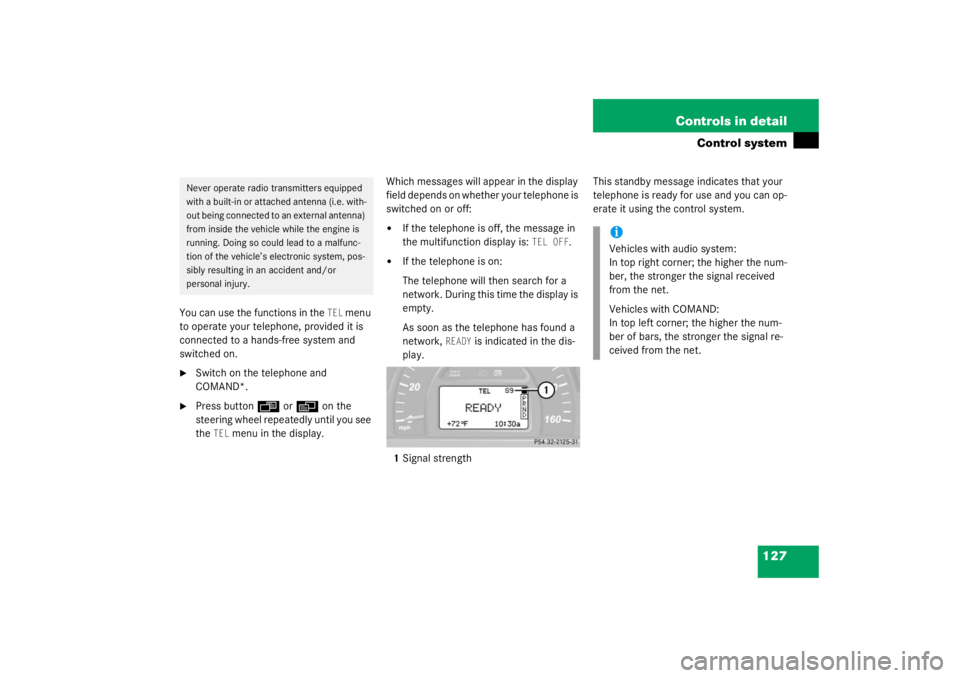
127
Controls in detail
Control system
You can use the functions in the
TEL
menu
to operate your telephone, provided it is
connected to a hands-free system and
switched on.
�
Switch on the telephone and
COMAND*.
�
Press button
ÿ
or
è
on the
steering wheel repeatedly until you see
the
TEL
menu in the display. Which messages will appear in the display
field depends on whether your telephone is
switched on or off:
�
If the telephone is off, the message in
the multifunction display is:
TEL OFF
.
�
If the telephone is on:
The telephone will then search for a
network. During this time the display is
empty.
As soon as the telephone has found a
network,
READY
is indicated in the dis-
play.
1 Signal strength This standby message indicates that your
telephone is ready for use and you can op-
erate it using the control system.
Never operate radio transmitters equipped
with a built-in or attached antenna (i.e. with-
out being connected to an external antenna)
from inside the vehicle while the engine is
running. Doing so could lead to a malfunc-
tion of the vehicle’s electronic system, pos-
sibly resulting in an accident and/or
personal injury.
iVehicles with audio system:
In top right corner; the higher the num-
ber, the stronger the signal received
from the net.
Vehicles with COMAND:
In top left corner;
the higher the num-
ber of bars, the stronger the signal re-
ceived from the net.
Page 128 of 356
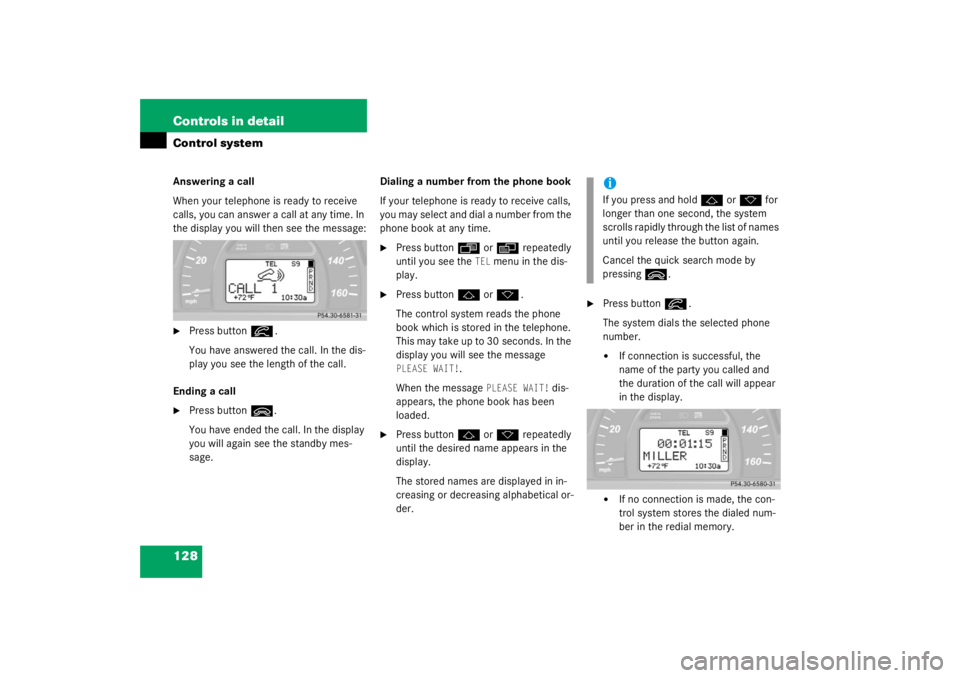
128 Controls in detailControl systemAnswering a call
When your telephone is ready to receive
calls, you can answer a call at any time. In
the display you will then see the message:�
Press button
í
.
You have answered the call. In the dis-
play you see the length of the call.
Ending a call
�
Press button
ì
.
You have ended the call. In the display
you will again see the standby mes-
sage. Dialing a number from the phone book
If your telephone is ready to receive calls,
you may select and dial a number from the
phone book at any time.
�
Press button
ÿ
or
è
repeatedly
until you see the
TEL
menu in the dis-
play.
�
Press button
j
or
k
.
The control system reads the phone
book which is stored in the telephone.
This may take up to 30 seconds. In the
display you will see the message
PLEASE WAIT!
.
When the message
PLEASE WAIT!
dis-
appears, the phone book has been
loaded.
�
Press button
j
or
k
repeatedly
until the desired name appears in the
display.
The stored names are displayed in in-
creasing or decreasing alphabetical or-
der.
�
Press button
í
.
The system dials the selected phone
number.
�
If connection is successful, the
name of the party you called and
the duration of the call will appear
in the display.
�
If no connection is made, the con-
trol system stores the dialed num-
ber in the redial memory.
iIf you press and hold
j
or
k
for
longer than one second, the system
scrolls rapidly through the list of names
until you release the button again.
Cancel the quick search mode by
pressing
ì
.
Page 129 of 356
129
Controls in detail
Control system
Redialing
The control system stores the most recent-
ly dialed phone numbers. This eliminates
the need to search through your entire
phone book.�
Press button
ÿ
or
è
repeatedly
until you see the
TEL
menu in the dis-
play.
�
Press button
í
.
In the display you see the first number
in the redial memory.
�
Press button
j
or
k
repeatedly
until the desired name appears in the
display.
�
Press button
í
.
The control system dials the selected
phone number.
Page 132 of 356
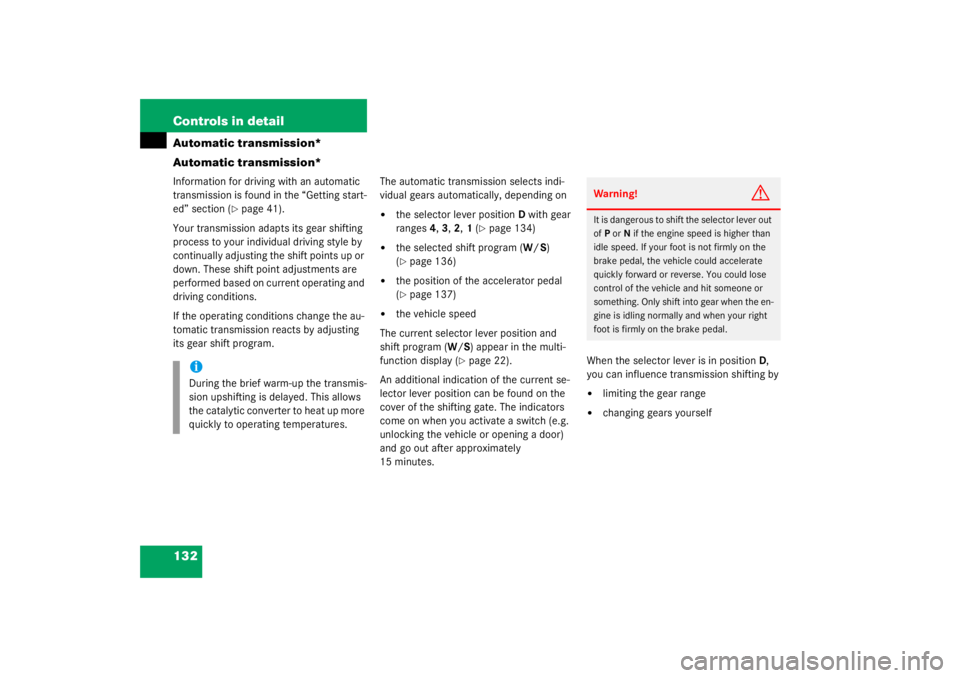
132 Controls in detailAutomatic transmission*
Automatic transmission*Information for driving with an automatic
transmission is found in the “Getting start-
ed” section (
�page 41).
Your transmission adapts its gear shifting
process to your individual driving style by
continually adjusting the shift points up or
down. These shift point adjustments are
performed based on current operating and
driving conditions.
If the operating conditions change the au-
tomatic transmission reacts by adjusting
its gear shift program. The automatic transmission selects indi-
vidual gears automatically, depending on
�
the selector lever position
D with gear
ranges 4, 3 , 2 , 1 (
�page 134)
�
the selected shift program ( W/S)
(�page 136)
�
the position of the accelerator pedal
(�page 137)
�
the vehicle speed
The current selector lever position and
shift program ( W/S) appear in the multi-
function display (
�page 22).
An additional indication of the current se-
lector lever position can be found on the
cover of the shifting gate. The indicators
come on when you activate a switch (e.g.
unlocking the vehicle or opening a door)
and go out after approximately
15 minutes. When the selector lever is in position
D,
you can influence transmission shifting by
�
limiting the gear range
�
changing gears yourself
iDuring the brief warm-up the transmis-
sion upshifting is delayed. This allows
the catalytic converter to heat up more
quickly to operating temperatures.
Warning!
G
It is dangerous to shift the selector lever out
of P or N if the engine speed is higher than
idle speed. If your foot is not firmly on the
brake pedal, the vehicle could accelerate
quickly forward or reverse. You could lose
control of the vehicle and hit someone or
something. Only shift into gear when the en-
gine is idling normally and when your right
foot is firmly on the brake pedal.
Page 133 of 356
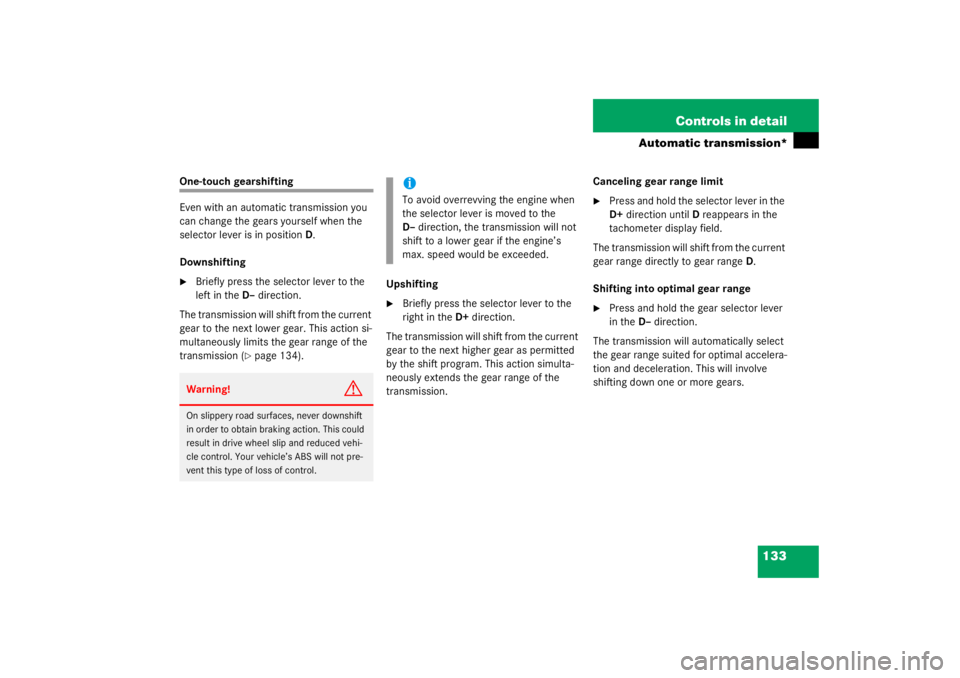
133
Controls in detail
Automatic transmission*
One-touch gearshifting
Even with an automatic transmission you
can change the gears yourself when the
selector lever is in position
D.
Downshifting�
Briefly press the selector lever to the
left in the D–direction.
The transmission will shift from the current
gear to the next lower gear. This action si-
multaneously limits the gear range of the
transmission (
�page 134). Upshifting
�
Briefly press the selector lever to the
right in the
D+direction.
The transmission will shift from the current
gear to the next higher gear as permitted
by the shift program. This action simulta-
neously extends the gear range of the
transmission. Canceling gear range limit
�
Press and hold the selector lever in the
D+
direction until D reappears in the
tachometer display field.
The transmission will shift from the current
gear range directly to gear range D.
Shifting into optimal gear range
�
Press and hold the gear selector lever
in the D– direction.
The transmission will automatically select
the gear range suited for optimal accelera-
tion and deceleration. This will involve
shifting down one or more gears.
Warning!
G
On slippery road surfaces, never downshift
in order to obtain braking action. This could
result in drive wheel slip and reduced vehi-
cle control. Your vehicle’s ABS will not pre-
vent this type of loss of control.
iTo avoid overrevving the engine when
the selector lever is moved to the
D– direction, the transmission will not
shift to a lower gear if the engine’s
max. speed would be exceeded.
Page 134 of 356
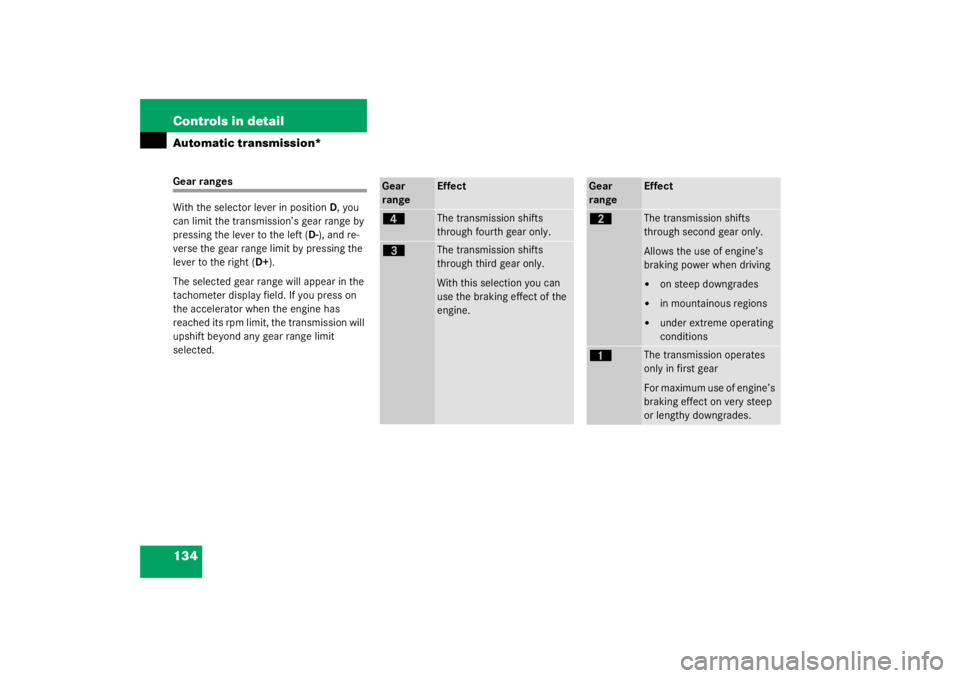
134 Controls in detailAutomatic transmission*Gear ranges
With the selector lever in positionD, you
can limit the transmission’s gear range by
pressing the lever to the left ( D-), and re-
verse the gear range limit by pressing the
lever to the right ( D+).
The selected gear range will appear in the
tachometer display field. If you press on
the accelerator when the engine has
reached its rpm limit, the transmission will
upshift beyond any gear range limit
selected.
Gear
range
Effect
é
The transmission shifts
through fourth gear only.
è
The transmission shifts
through third gear only.
With this selection you can
use the braking effect of the
engine.
Gear
range
Effect
ç
The transmission shifts
through second gear only.
Allows the use of engine’s
braking power when driving �
on steep downgrades
�
in mountainous regions
�
under extreme operating
conditions
æ
The transmission operates
only in first gear
For maximum use of engine’s
braking effect on very steep
or lengthy downgrades.
Page 136 of 356
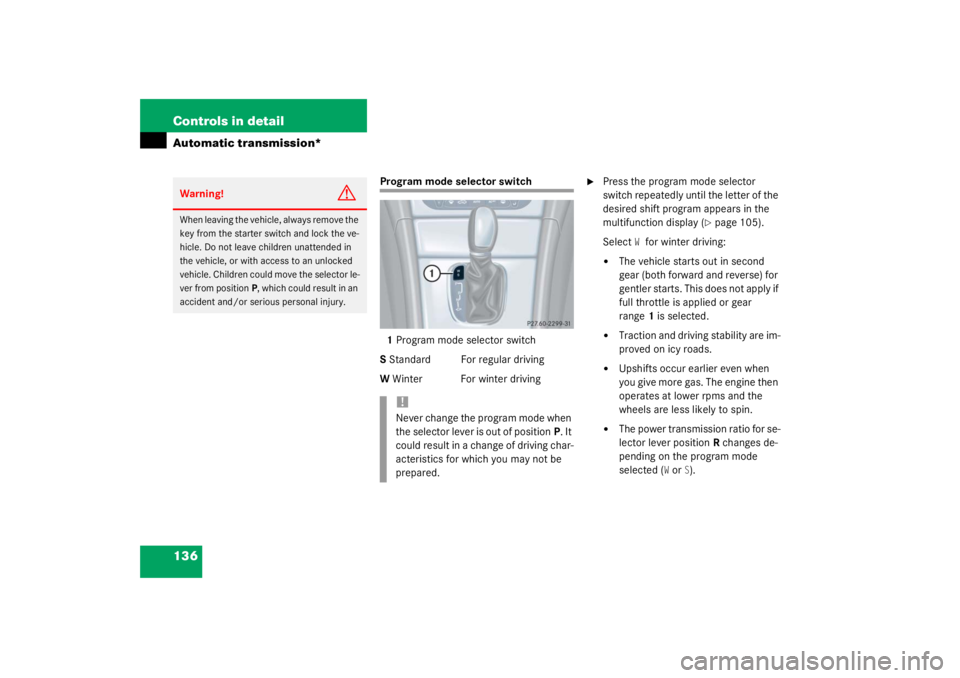
136 Controls in detailAutomatic transmission*
Program mode selector switch1 Program mode selector switch
S Standard For regular driving
W Winter For winter driving
�
Press the program mode selector
switch repeatedly until the letter of the
desired shift program appears in the
multifunction display (
�page 105).
Select
Wfor winter driving:
�
The vehicle starts out in second
gear (both forward and reverse) for
gentler starts. This does not apply if
full throttle is applied or gear
range 1 is selected.
�
Traction and driving stability are im-
proved on icy roads.
�
Upshifts occur earlier even when
you give more gas. The engine then
operates at lower rpms and the
wheels are less likely to spin.
�
The power transmission ratio for se-
lector lever position R changes de-
pending on the program mode
selected (
W or
S).
Warning!
G
When leaving the vehicle, always remove the
key from the starter switch and lock the ve-
hicle. Do not leave children unattended in
the vehicle, or with access to an unlocked
vehicle. Children could move the selector le-
ver from position P, which could result in an
accident and/or serious personal injury.
!Never change the program mode when
the selector lever is out of position P. It
could result in a change of driving char-
acteristics for which you may not be
prepared.